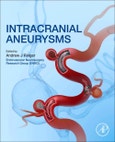Intracranial aneurysm result from complex interactions between cerebrovascular anatomy, vascular injury, and adaptive remodeling of the arterial wall and represent a cerebrovascular disorder with the potential for substantial morbidity and mortality. Most intracranial aneurysms occur in the larger arteries near the skull base, in or around the circle of Willis, but variants may appear virtually anywhere in the cerebral vasculature. The aneurysm can leak or rupture, causing life-threatening bleeding, and is the most common cause of spontaneous subarachnoid hemorrhage, the third most common form of stroke. Intracranial aneurysms affect about 1 in 10,000 people per year in the United States (approximately 27,000). Intracranial Aneurysms will address the natural history, biology, and basic management principles and treatment of aneurysms. The chapters also explore the unique features of each type or location of aneurysm while considering the medical, surgical, and endovascular options. Contributions are by members of the Endovascular Neurosurgery Research Group, a group of recognized expert neurosurgeons who specialize in cerebrovascular and endovascular management of aneurysms.
Please Note: This is an On Demand product, delivery may take up to 11 working days after payment has been received.
Table of Contents
1. Background2. Evaluation and Management of Aneurysms and SAH
3. Surgical Techniques
4. Endovascular Techniques
5. Specifics of Aneurysm Treatment
6. Atypical Aneurysms








